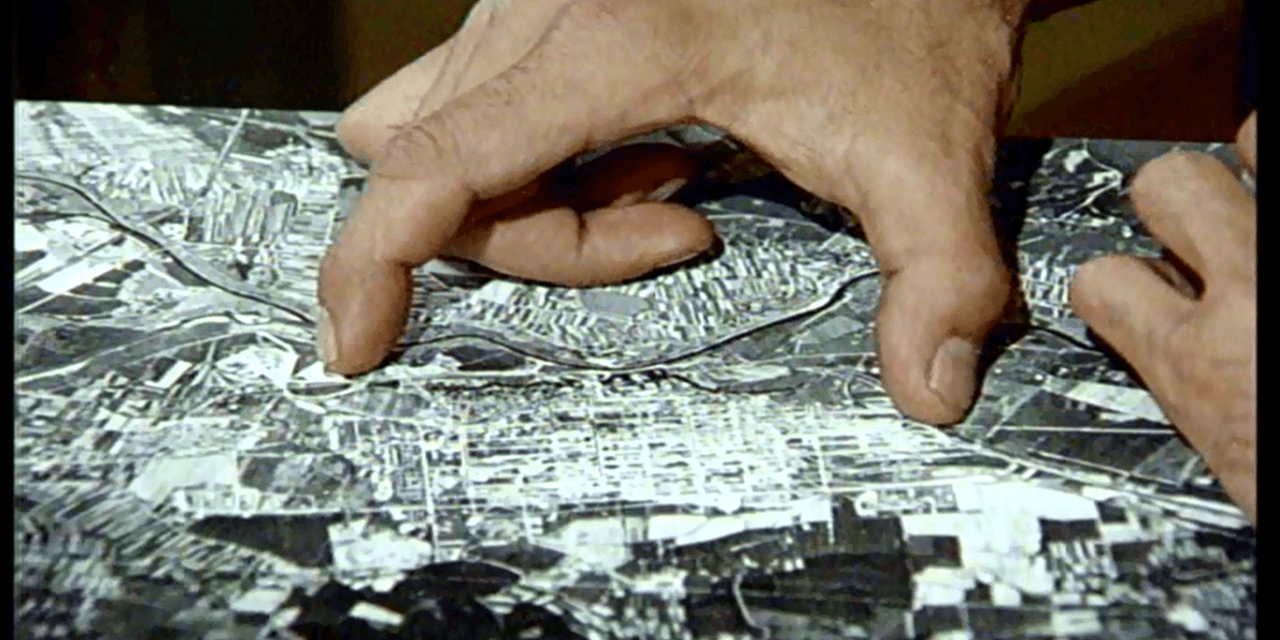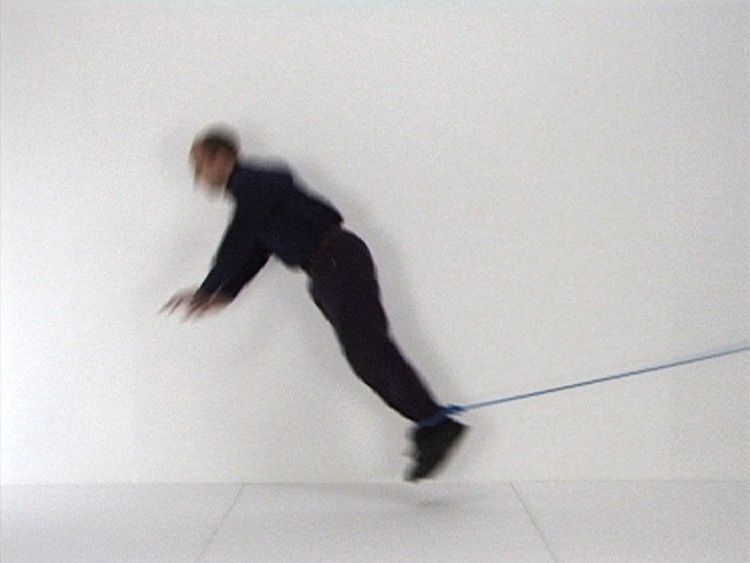I would like to measure my breath in relation to the air between us
John Cage[1]
This is a poetic text about flights and air bodies. It is composed by three kinds of flights or journeys: ascent, return and fall. I will be analysing images that, although seemingly motionless, awake the memory of certain falls. The most important thing here is to fall once again.
A Story About How To Observe The Earth
What is the relationship between the ways in which the world has been represented throughout history and the different perspectives provided by technological advancements to look at the Earth? How do these representations relate to human existence and, especially nowadays, our current condition as residents of the digital world and an economy that emphasises flexibility and instability?
In his book In the World Interior of Capital: For a Philosophical Theory of Globalization (2007), Peter Sloterdijk explains how the different ways to represent Earth occur alongside a shift of perspective and orientation of the earthling’s body towards the world. The images that represented the world came from mythology, geography, or astrology, and for Sloterdijk they constitute what he calls the history of terrestrial globalization. Although he focused on western history and its own history of science, I’m interested in highlighting only those images that are intimately linked to the aesthetics of a movement or flight; the movement of a body that goes out of space and returns (or not), to planet Earth.
As pointed out by Sloterdijk, first there was the cosmic-Uranian globalization, defined during Ancient Times, when it was thought that Earth was the centre of the universe, and the world was only observable from inside. Planet Earth was sustained by the god Uranus and the sky was understood as a benevolent roof that protected and calmed the human fear of fall. The only way to travel outside Earth was through the ascent from which there is no return: death. The sky was the kingdom and domain of gods and ghosts.
Later came the morphological-globalization, characterized by the expeditions of European explorers that “discovered”, colonized and generated the image of the world map from the XV century onwards[3]. Cartography is developed through technological advancements that make possible to measure Earth and build its image, a science carried by the standards of an economy of space conquest – that is, cartography is based on a colonizing mentality where space can be not only calculated and measured but distributed.
However, Sloterdijk suggests, during Modernity, non mythical cosmology is promoted and comes to constitute the principal of all forms of de-localization of gaze and body. Cosmology, as science and philosophy, established new ways of thinking of planet Earth from the outside. Alexander von Humboldt, polymath from S. XIX, in his treatise Kosmos (1865-62), was one of the first to describe the earth from outside. For Modern Europeans, this change of perspective presented the image of the world facing an unprotected sky without gods. The gaze from outer space represents, in the words of Sloterdijk, “the outside (as) the general from-where of all possible returns”[4].
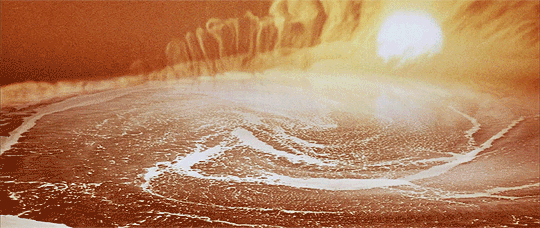
Image from Solaris, Andrei Tarkovsky, 1972. “We don’t want to conquer the cosmos, we want to extend the boundaries of Earth to the cosmos. We are only seeking Man. We don’t want other worlds, we want mirrors”.
While images and narratives from cosmology – and afterwards astrophysics – took precedence over the Ancient mythical constellations, the interpretation of planet Earth as a wandering star arose. The vertical gaze towards the world was opposed to the idea of metaphysical ascension and devised instead as a descent flight, where Earth is the airport. Once the world is thought in its verticality, it is no longer conceived of as an intermediate layer between sky and hell, but as a body travelling adrift, because the limits of the universe are unknown and imperceptible. The idea of descending into Earth brings with it the desire to secure other notions such as stability and ways to protect oneself against the outside – now, all that is exterior to the World is considered a place of horrors. Earth is the only place where it is safe to live. As pointed out by Sloterdijk, during Modernity, bourgeois notions such as the home and private space as shelter, emerge; intimacy belongs to the household, and home is the box seat from which to observe the world theatre[5].
The third globalization, the electronic-globalization, is defined by Sloterdijk as a synchronized world where everything is connected thanks to technology. However, I would suggest that the downhill flight does not disappear, but rather, it continues, and together with all the technological advancements and the capitalist economy, it opens ways to delocalize and disorient gaze and body. In 1972, more than one hundred years after Humboldt’s treatise, the famous Blue Marble entered the picture. It was taken by NASA astronauts aboard Apollo 17 and it was not only the first photograph of the Earth but the first image of the whole Earth. Western society was waiting[6] for this image as a confirmation of ideals such as those of ecological movements as well as technological advancement, that set up the Silicon Valley’s ideology that prevails till today[7].
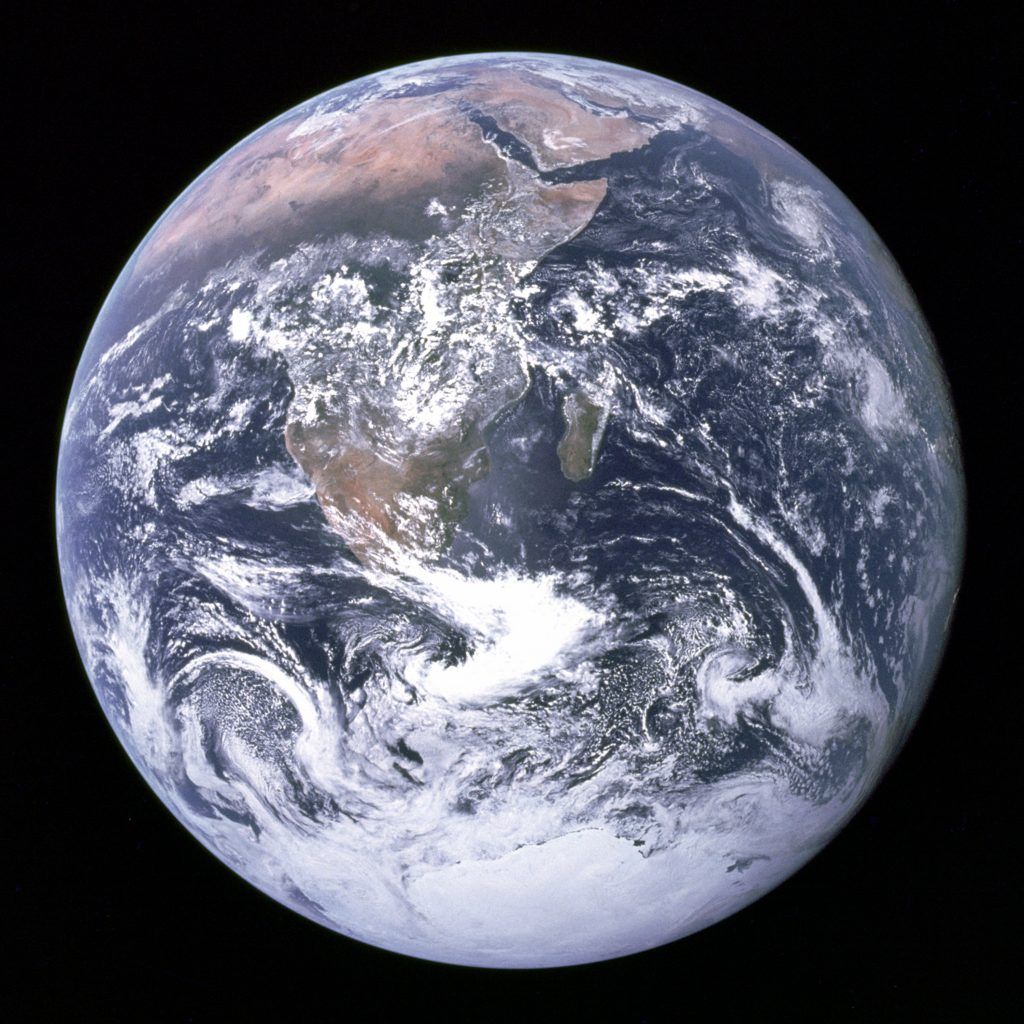
Image of the Earth taken from Apollo 17, 1972
Space became a place of conquest and, observed from without, the Earth’s dimensions could now be altered and thereby further controlled. From this moment, Earth was not only a wandering star but a system man could and must govern to survive. This idea was reflected, for example, in notions such as Buckminster Fuller’s Spaceship Earth – a concept that resonates with Cybernetics, in full swing at that time, and its idea of Earth as a system. Planet Earth is imagined as a huge intelligent machine that man can control. In Operating Manual for Spaceship Earth (1968), Fuller warned «You do not belong to you. You belong to the universe». A formula that defined the world as a whole connected by communication technology and new transport infrastructure, not only observable but controllable from the outside – let’s think of all aerial observation technology that surround us and the planet. Now earthlings, as in Fuller’s words, are astronauts captive of the economy of the technological-capitalist universe.
The Blue Marble was followed by images such as the Pale Blue Dot – another of the many photographs that NASA collects till today. Pale Blue Dot was taken in 1990 by the Voyager 1 from a distance of more than six thousand million kilometres from Earth, and it was named dot because in this picture the World wasn’t bigger than a pixel. This image coincides with the rise of the Internet, and it seems to already suggest and advance the meaning of Earth as object available at the click of a mouse – a notion completely rooted in our everydayness[8].
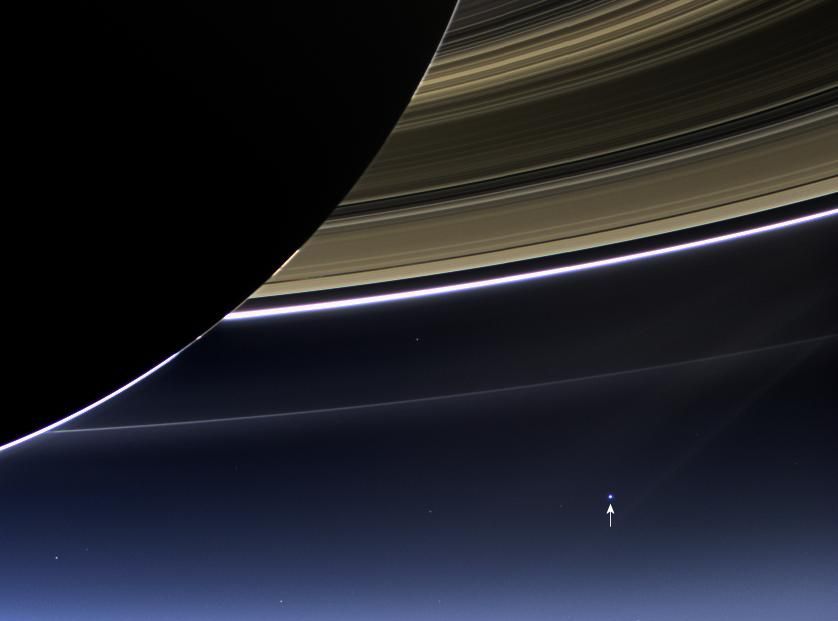
Image of Pale Blue Dot, 1990.
The Horror/Love of the Fall
Four years ago, when space missions seemed to proliferate in the whole world[9], Alfonso Cuarón made the film Gravity (2013), that, in my opinion, not only criticised the myth of power and control spread by NASA with its technological developments, but also placed us before the gravity of the aesthetics of descent. Cuarón’s film is a space odyssey, as many others, where the spectator is introduced to an atmosphere of anxiety to hold, embrace and return to Earth – the solid ground provided by gravity. The fear of losing control of the spacecraft is embodied by the astronaut Sandra Bullock, who literally embodies the wandering star metaphor.
Wandering stars, for whom it is reserved
The blackness of darkness forever [10]
However, this descending body who looks at the world from outside and finds itself as an errant, floating and falling body, not only discovers its own disorientation as a body without fixed plane, but, as pointed out by Hito Steyerl in her text In Free Fall: A Thought Experiment on Vertical Perspective, (2011), it reveals the condition of its own existence. In her essay, Steyerl connects the history of the horizon line as symbol of orientation with our current condition, which she describes as a condition of disorientation or in free fall. Here, the term disorientation refers to a state of impossible fixed position of the body in relation to the Earth, as well as the impossible formulation of “metaphysical claims or foundational political myths” through, for example, philosophical discourses[11]. Virtual images create multi-focal and non-linear realities, where everything is contingent and unstable. However, as posed by Steyerl, the disoriented gaze perhaps sees a more accurate version of the world than those that try to set gravity as ordering principle. “Falling is corruption as well as liberation, a condition that turns people into things and vice versa. It takes place in an opening we could endure or enjoy, embrace or suffer, or simply accept as reality.” This is the fall that was already celebrated and promoted since the Blue Marble (1972), and culture echoed this idea through, for example, songs such as David Bowie’s Space Odyssey, where Ground Control was calling astronaut Major Tom, who resisting gravity, decided to never come back to Earth, or the film Silent Running, also from the same year, that proposed to save the Earth – after humans had destroyed it – in a greenhouse spaceship that could travel the universe forever. Both Silent Running‘s greenhouse spaceship and Major Tom, threw themselves into the universe without return.
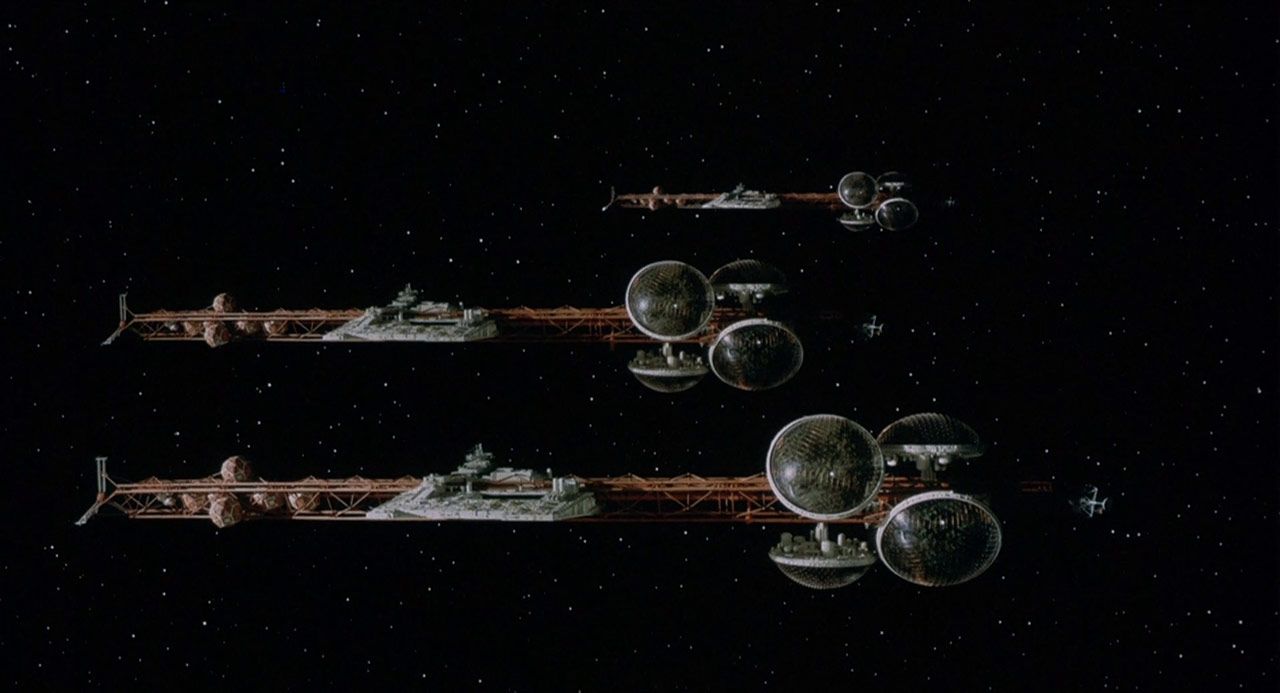
Film still from Silent Running, Douglas Trumbull, 1972
Even though this aesthetics might have had some revivals, what remains – almost as an existential necessity– is this descent to Earth that constantly disarticulate the codes of reference inside/outside, protected/unprotected, vertical/horizontal, belonging/erring, object/subject or even normal/abnormal. The old idea of the wandering star may last till today as a paradigm for other ways to dwell on planet Earth, and as the existential condition of the nomads; of the ones in constant adaptation; those looking for a job; those applying for scholarships; those who believe in Europe; those who don’t have a fixed identity; the deviant; or the divided selves. Aren’t we the precarious, the masters of the fall, standing up from the floor 24/7 without rest?
We may recall the 2017-18 program Let’s Get Real Here organized by the collective Storm and Drunk from Madrid. With this project, they poetically call for “living in the fall” or “embracing the fall to know how to float”. Their first exhibition Oxygen is flowing by the artist Álvaro Chior, curated by Raisa Maudit, follows this premise. In his video, with the same title, the artist presents to us the world of sensations of falling. One of the most common one is floating, a sensation also described in Steryerl’s essay. This sensation seems to respond to complete body disorientation – a body that does not move towards the ground. However, the aesthetics of this movement do not relate to an inside or outside of Earth but to the experience of the digital world, the cloud – the new container of the world of data and information. Here, someone does not fall with their own body but their I-data, I-password, I-files or I-facebook-profile; a body, as proposed by Chior, that is hurt while at the same time relieved, when it loses its I-files. The voice over in Oxygen is flowing says: “Nowadays it feels like you are in an airplane, so high, so fast and with so much invisible pressure that you don’t feel anything. Falling into the void, at least you become conscious of falling.”

Image for the exhibition of Álvaro Chior Oxygen is flowing, 2017 at Storm and Drunk.
The digital world cancels the aggression of falling and deletes the floor that seemed to wake bodies up with its violent way of existing.
But should I go dizzy I crash down into the floor;
my face into the floor, my attention bleeding into the
cracks of the floor[12].
Falling in the digital world means falling in a modulated way. Perhaps the floor has not disappeared but become somehow softer, a type of floor that allows bodies to be modulated as they fall. Imagine you cannot fall. Álvaro Chior proposes with his work that bodies remain in a state of pre-crash. In digital electronic systems, an unstable equilibrium or metastable state means that the system cannot stable or resolve into 0 or 1. A metastable state is considered an error in the system, since the system is not able to give a result. There is blockage and accumulation.
The Sky above the port was the colour of television, tuned
to dead channel [13]
The signal of a dead channel does not stop but stops transmitting images. Information and algorithmic operations never stop, however the feeling of accumulated time seems to be felt in terms of velocity. We may become digital-world and internet-world through our moods, states or emotions. The question here is that, digital technology and its way of mediating the world, does not delocalize the body or produce a lack of balance because it eliminates Earth’s horizon. Rather, it engages with human senses further than the visual, it does not only disrupt the world’s proportions but velocities – mediation materialises in levels of speed. As suggested by the work of Chior, it seems we are immersed in the feeling of flying or floating but… should we throw ourselves against the floor instead, like Bas Jan Ader or John Wood and Paul Harrison did, in order to feel it? Or shall we wait for a mistake to happen and fall by surprise? Aren’t the unexpected event or the trip over something, the causes of all kind of falling? Even Icarus fell because of a technical error.
Even though we believe we will not fall, we do. Although everything seems to happen faster, it is only the pressure of punctuality. Travelling to the speed of light means hibernation. Some people teeter in the void of virtual reality.
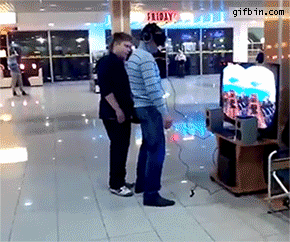
Others fake their fall, like this kid who pretended to fall of his bike while his father is filming him. And why not? Why not return to the world the zero gravity that keeps us afloat? This way, aren’t we becoming aware of the position of our body and the velocity of our fall? Why not to fall slower and more fragile, like measuring the air between us?
- Front image: Harun Farocki, Images of the World and the Inscription of War (1988)
[1] ^ Kuhn, Laura, The selected letters of John Cage, Wesleyan, 2016.
[2] ^ Sloterdijk, Peter, In the World Interior of Capital: For a Philosophical Theory of Globalization, Polity Press, Cambridge, 2007.
[3] ^ The morphological globalization specifically refers to the period of time between 1492 and 1945, what historians name as Modernity. However, and even though there is no time here to develop this point, it is important to question this forms of globalization and the fact that this logic repeats in other periods of time.
[4] ^ Ibid.
[5] ^ Sloterdijk mentions this in relation to Walter Benjamin, “who summed up the meaning of bourgeois solitudes: ‘For the private individual, the private environment represents the universe. In it he gathers remote places and the past. His drawing room is a box in the world theatre’ ”.
[6] ^ Stewart Brand made this pin in which he claimed “Why haven’t we seen the photograph of the whole Earth yet?”, before the first image of the whole earth was taken
[7] ^ In 2014 I wrote the article, The age of insiders, for the journal Re-visiones,, where I talk about this more extensively.
[8] ^ This image was emblematic for Carl Sagan in his Pale Blue Dot: A Vision of the Human Future in Space, 1994, and inspired his famous text (first chapter of the book) You are here (Retrieved 30-10-2017).
[9] ^ As pointed out by Adam Mann in his article Space 2013: A New Year of Missions and Events (Retrieved 30/10/2017), during 2013 space missions and agencies proliferated and embarked in new travels to outer space. In this sense, NASA was confronted with its own reality: it is a Cold War relic that it has always been looking for new ways of reinventing itself and financing, especially regarding China’s pressure with its growing economy and their investments in space missions.
[10] ^ Portishead, «Wandering stars», 1994.
[11] ^ Regarding this point, Hito Steyerl refers to Oliver Marchart, Post-Foundational Political Thought: Political difference in Nancy, Lefort, Badiou and Laclau, Edinburgh: Edinburgh University Press, 1997. See note 1 of Hito Steyerl’s article “In Free Fall: A Thought Experiment on Vertical Perspective”.
[12] ^ Russell Edson, The Floor, 1973.
[13] ^ William Gibson, Neuromancer, 1984, p.1.

